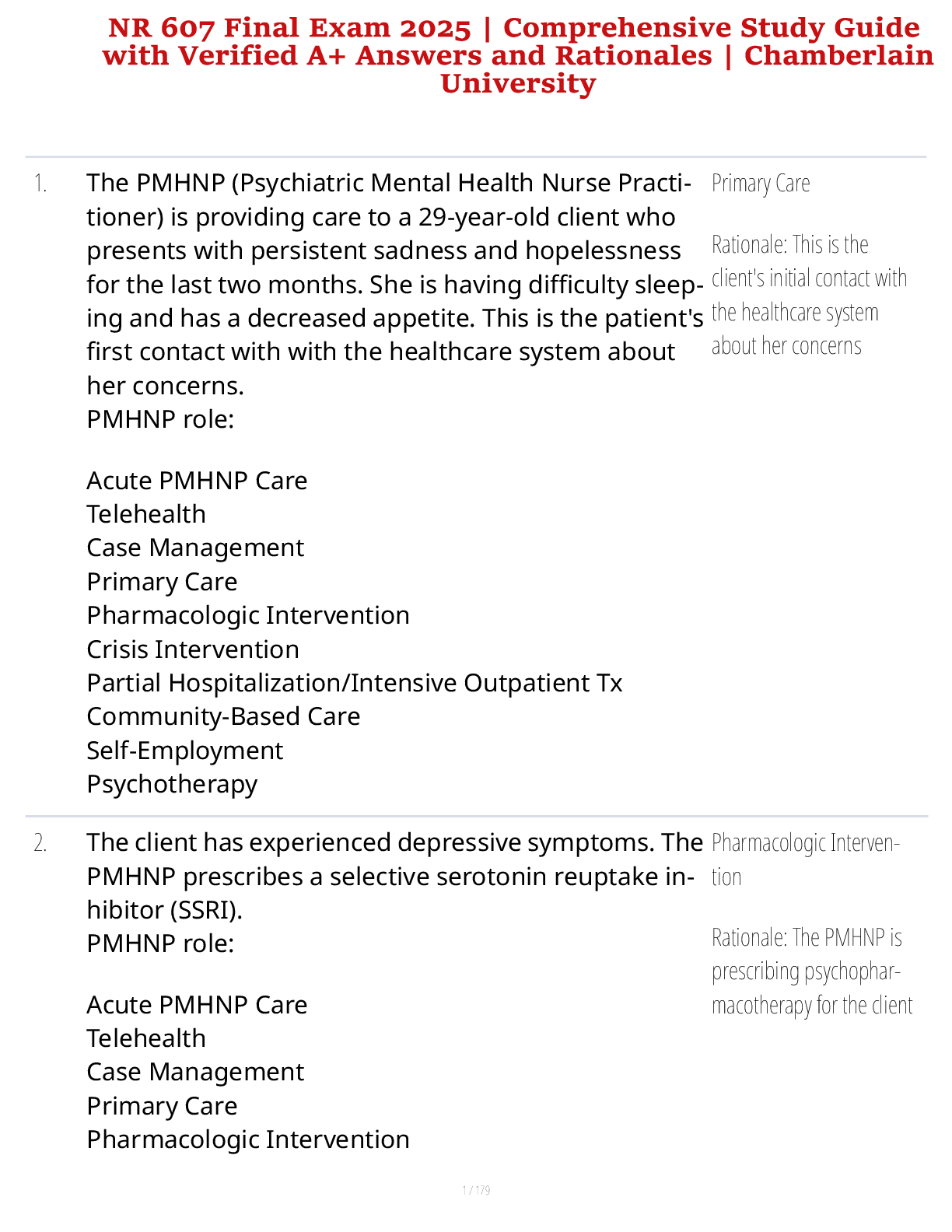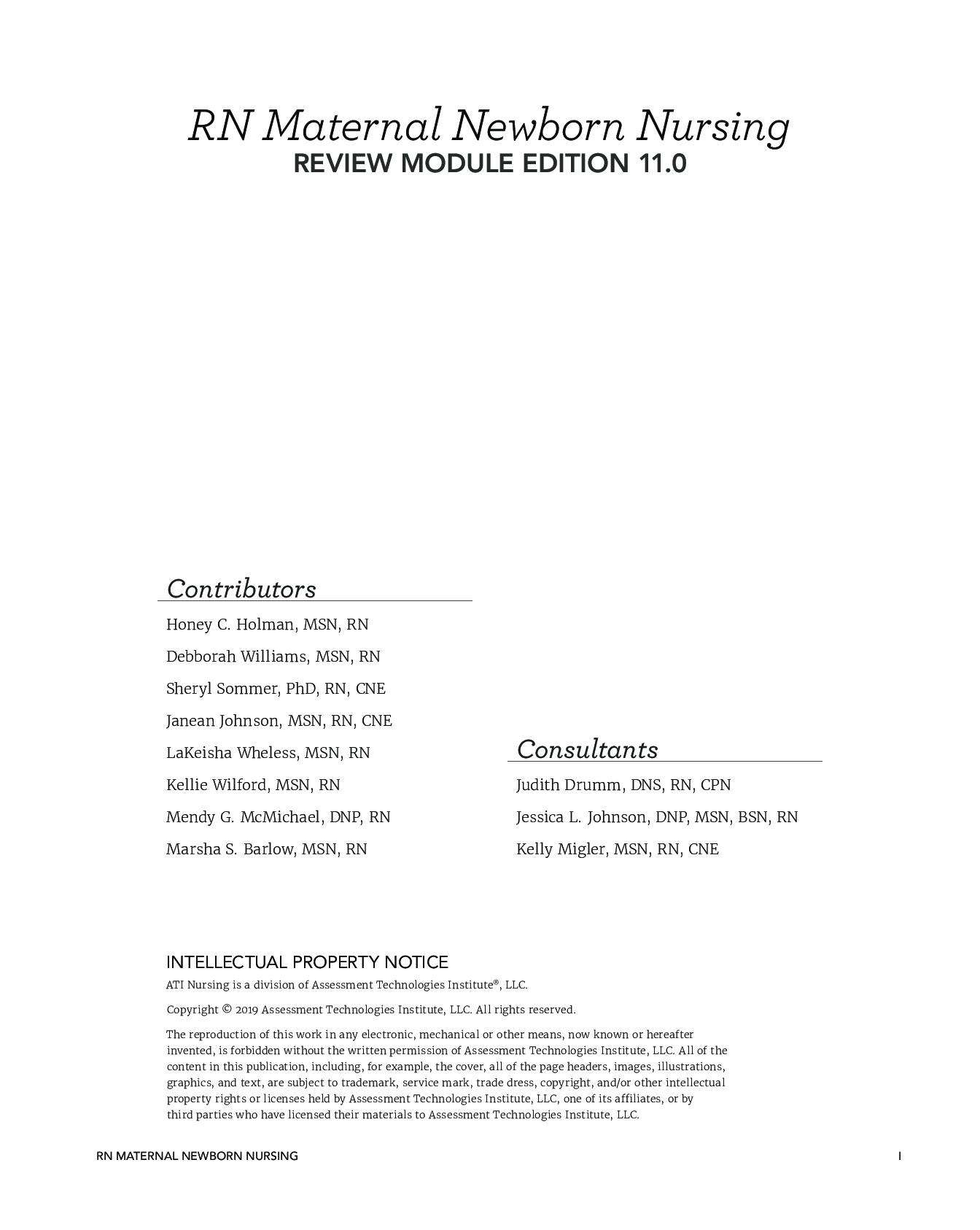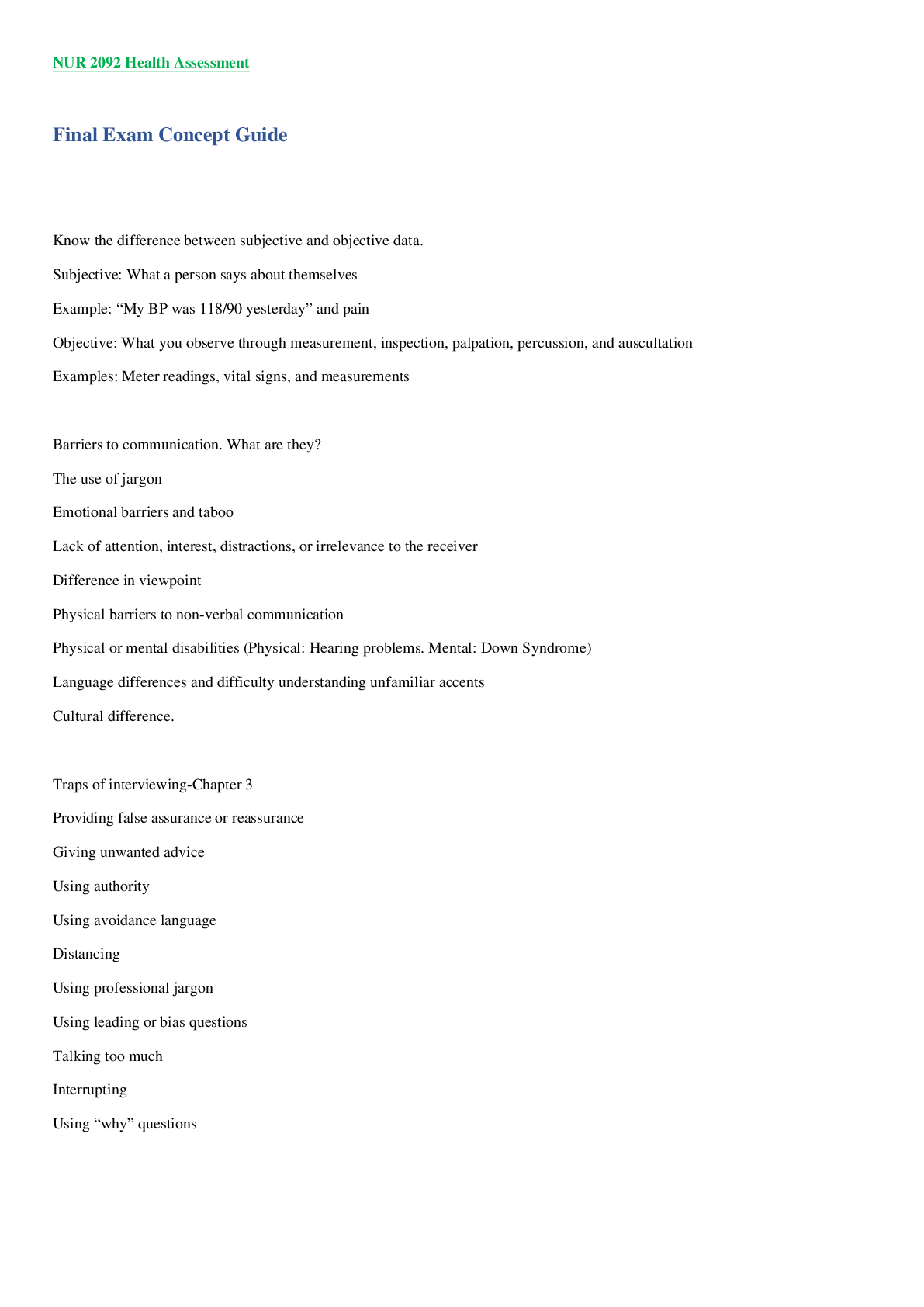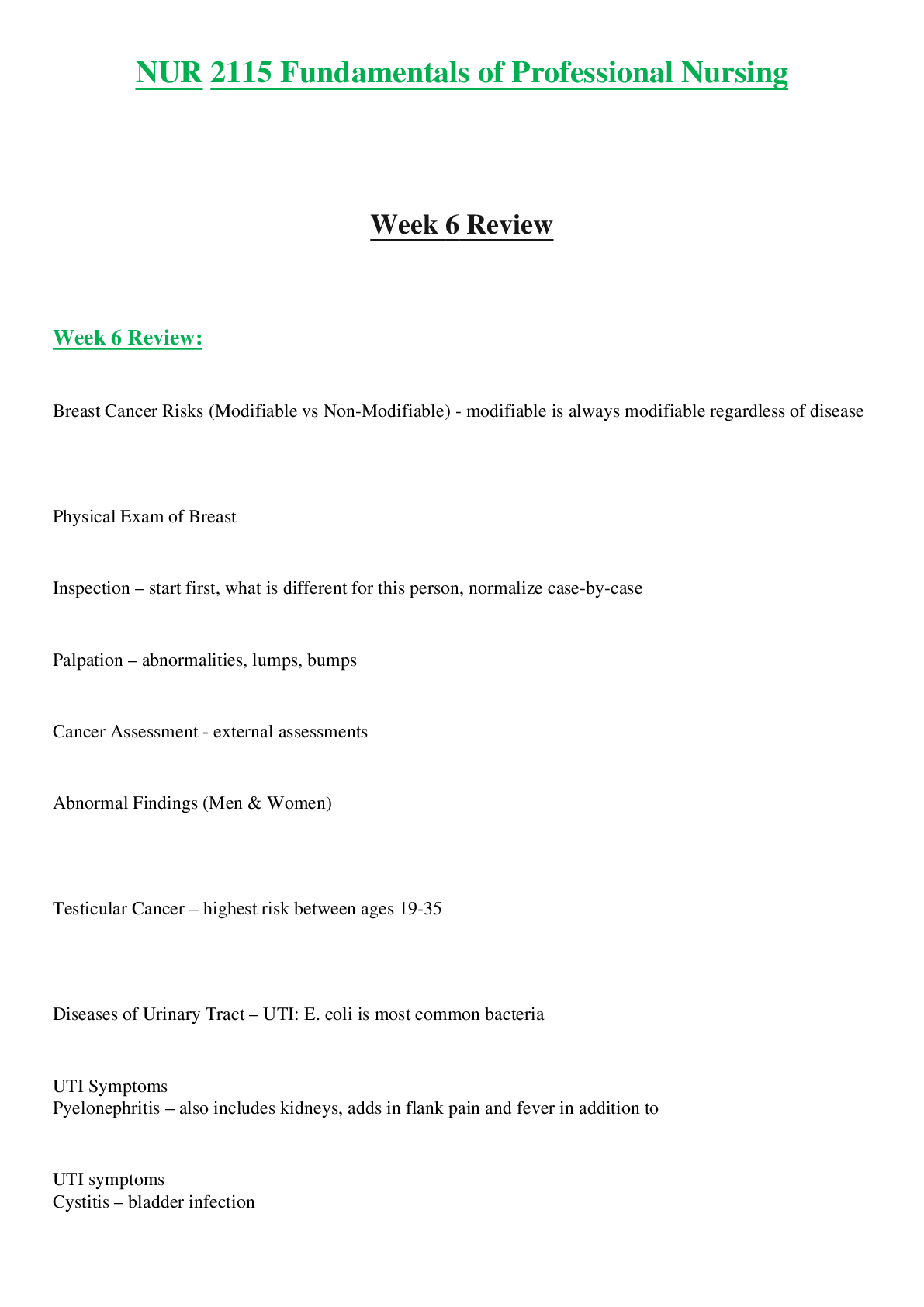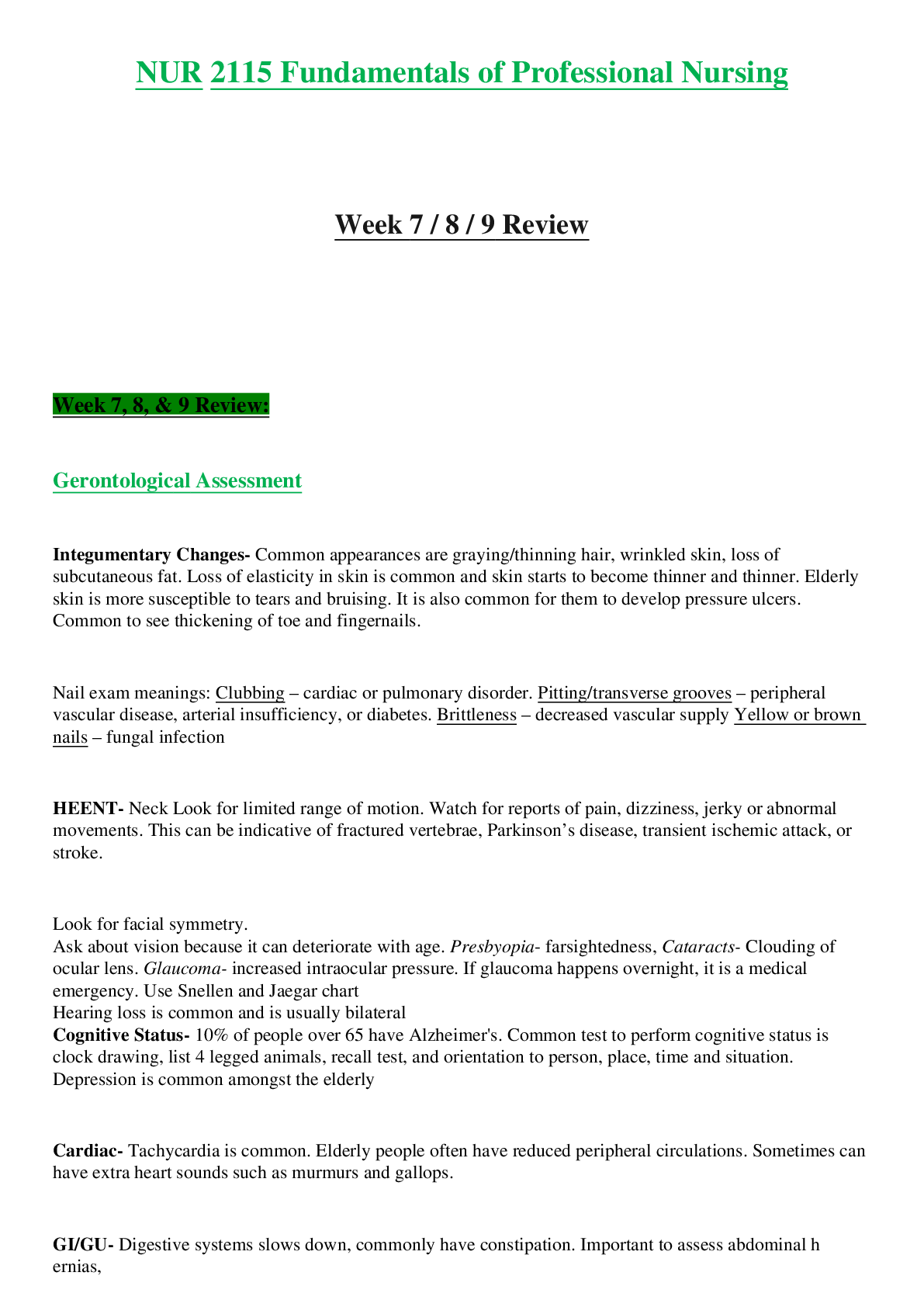*NURSING > STUDY GUIDE > EMT Final Exam Study Guide. Most Comprehensive Content for a quick read right before EXAM (All)
EMT Final Exam Study Guide. Most Comprehensive Content for a quick read right before EXAM
Document Content and Description Below
SAMPLE Cassandra Foppe FINAL EXAM EMT 104 1. List signs and symptoms of stroke: - Facial drooping - slurred speech - a sudden and severe headache - sudden weakness or numbness in the face, arms, ... legs, or one side of the body - lack of muscle coordination - sudden loss of vision - difficulty swallowing - decreased level of responsiveness 2. List Basic life support treatment for an infant, child, or adult in cardiac arrest: Infant: PPE, scene safe, call for ALS and transport, get AED, start compressions 30:2 for 1 rescuer do it with index and middle finger right and middle finger below nipple line mark. With two rescuers its 15:2 compressions place hands side by side middle of chest, with positive ventilations. rapid transport. Child: PPE, scene safe, call for ALS and transport, get AED, start compressions 30:2 for 1 rescuer. 2 rescuers 15:2. rapid transport Adult: PPE scene safe, call for ALS back up, get AED, start compressions 30:2. rapid transport. 3. List normal vital signs (BPs, pulse rates, and respiratory rates) for an infant, child, and adult: Infant: BP: 70-90 mm/Hg systolic pulse: 140 to 160 per min breathing: 25-50 breaths/min temp: 96.8 to 99.6 Child: BP: 70-120 mm/Hg systolic pulse: 70-130 per min breathing: 20-30 breaths/min temp 98.6 Adult: BP: 120/80 mm/Hg or 100+age/80 pulse: 60-100 per minute breathing: 12-20 temp: 98.6 4. List signs of chronic bronchitis: -excess mucus production -fatigue -fever -chronic cough -difficulty with expirationCassandra Foppe FINAL EXAM EMT 104 5. Describe functions of the pulse oximeter: - to measure the oxygen saturation. 6. List treatment for a rattlesnake bite: - Calm the patient -Mark the bite with a pen to see if swelling increases -Clean bite gently -immobilize pressure -look for anaphylactic shock -DO NOT give anything orally -bring the snake in if dead -Vital - rapid transport 7. Define Kussmauls’s breathing pattern: -diabetic ketoacidios; deep respirations, deep in labor 8. Describe features of the bag-valve-mask (BVM): -air/ oxygen intake valve -nonrebreathing valve -02 reservoir -exhalation port -outlet valve -non pop off valve -one way valve system -transport face mask 9. List treatment for an open chest wound: -Occlusive dressing anterior tape on three sides or four sides to be able to burp dressing. Posterior taped on all four sides. 10. List signs and symptoms of an allergic reaction caused by an insect sting: -Redness -swelling in the area of sting (wheal) -difficulty breathing -altered mental status -warm to the touch 11. List the descending order of the divisions of the spine: a. Cervical (7) b. Thoracic (12) c. Lumbar (5) d. Sacral (5) e. Coccygeal (4)Cassandra Foppe FINAL EXAM EMT 104 12. Describe management of a newborn: -umbilical cord -airways -APGAR (Appearance, Pulse, Grimace, Activity & Respiration) -Warm 13. List treatment for severe asthma attack: -02 (oxygen), rapid transport, & Medical control to assist with meter-dosed inhaler 14. List ways in which an allergen can enter the body: -direct contact, indigestion, inhalation, or injection 15. Describe the mechanism of action of Aspirin, Glucose, Activated Charcoal, & Nitroglycerin: Aspirin: Generic Name: acetylsalicylic acid (ASA), Classification: antiplatelet, analgesic, nonsteroidal anti-inflammatory drug (NSAID), antipyretic. Mechanism: decreases synthesis of thromboxane A2, prevents platelets from clumping (aggregating) thereby decreasing formation of new blood clots. Indication: EMT’s Only use for cardiac chest pain Initial dose: (4)X 81 mg or 324mg tablet Side effects: nausea and vomiting, stomach pain, bleeding, allergic reaction. Glucose: Generic Name: Glucose Classification: carbohydrate, oral hyperglycemia. Mechanism: increases glucose blood level, provides glucose for cellular metabolism. Indication: low blood glucose level in the blood (hypoglycemia) Initial dose: 15 grams tablet or pouch / 25grams tablets or pouch Side effects: nausea and vomiting Activated charcoal: Generic Name: Activated charcoal Classification: Adsorbent Mechanism: binds with inactivates toxic substances in the gastrointestinal tract. Indication: recently ingested overdose, recently ingested poisons Initial dose: 15 grams, 25 grams, 50 grams prefixed in bottle or tube Side effects: nausea and vomiting Nitroglycerin: Generic Name: Nitroglycerin Classification: Vasodilator, antianginal Mechanism: relaxes the muscular walls of coronary arteries and veins. Relaxes the arteries throughout the body, results in less blood return to the heart, decreases blood pressure. Indication: chest pain suggestive of angina or acute myocardial infraction. Initial dose: .4mg tablet multi dose spray bottle (0.4 mg/ single spray) Side effects: hypotension, tachycardia, headache, dizziness, syncope, nausea and vomiting, burning under the tongue.Cassandra Foppe FINAL EXAM EMT 104 16. Identify functions of the Kendrick Extrication Device (KED): - A device designed to immobilize the patient until he or she is moved from a sitting position to a supine position on a backboard. 17. Define Body Mechanics: -the way the body moves to perform a specific action. 18. Identify risks for adults drowning: - spinal injuries, hypoxia, water in the lungs, unconsciousness 19. List parts of the: a. Skull i. Frontal bone (forehead) ii. Parietal bone (sides of top of skull) iii. Temporal bone (between parietal and zygomatic) iv. Nasal bone (nose) v. Zygomatic bone (cheek bone) vi. Maxilla (roof of mouth) vii. Mandible (bottom of mouth) viii. Foramen magnum (hole to connect spine) ix. Occipital bone (back of skull) b. Pelvis i. Sacrum (tail bone) ii. Ilium (hips) iii. Ischium (butt bones) iv. Pubis v. Acetabulum vi. Pubic symphysis vii. Iliac crest 20. List treatment for a seizure: -let seizure pass and protect patient from any harm (due to seizure) -manage and access ABC’s (airway, breathing, & circulation) -use suction to clear the airways -manage pulse saturation with pulse oximeter -apply 02 (oxygen) -ready for transport 21. Identify conditions for rapid extrication: -Vehicle or scene/ situation not safe -explosive or other hazardous material or there is fire or danger of fire -patient cannot be properly assessed -patient has life threating conditionsCassandra Foppe FINAL EXAM EMT 104 22. List treatment for severe hyperthermia caused by environmental exposure: -Cool environment, oxygen, clothing, shock, sip water, moist towels 23. List treatment for a burned eye or eyelid injury: - Flush with water, cover with moist towel 24. List conditions likely found on a medical identification bracelet: -DNR -Heart conditions -Diabetic -Allergies -Seizures (epilepsy) 25. Identify risks for suicide: -depression at any age -the feeling of being trapped or purposeless -previous suicide attempt -specific plan for suicide -family history of/ with suicide 26. List signs and symptoms of inadequate breathing for an infant, child, and adult: -Reports difficulty of breathing or shortness of breath -Altered mental status -Appears anxious ( Children will appear sleepy or lifeless) -Respiratory rate too fast or slow -Irregular breathing rhythm -Skin is cool, clammy, pale or cyanotic -Wheezing, gurgling, snoring, crowing, or stridor -Decreased or noisy breath sounds on one or both sides of chest 27. List stages of death and dying: -denial -anger -hostility -bargaining -depression -acceptance 28. List treatment for low blood pressure in an adult: -Treat for shock 29. List common medical disorders/ conditions found in children and the elderly: Children: Elderly: -poisoning -seizures -SOB -depression -drowning -meningitis -chest pain -abuse -croup -epiglottis -falls -loss of independenceCassandra Foppe FINAL EXAM EMT 104 30. Define gallbladder: -A sac on the undersurface of the liver that collects bile from the liver and discharges it into duodenum through the common bile duct. 31. Define the platelets and white blood cells: a. Platelets: responsible for the formation of a blood clot to stop bleeding b. White blood cells: blood cells that have a role in the body's immune defense mechanisms against infection; also called leukocytes. (Defends the body). 32. Describe the Log roll: - c spine stabilization, DNVF testing/ PMS test, rolling on to back board on the head mans count. 33. List treatment for suspected child abuse: - Document findings, report to PD 34. Define sudden infant death syndrome (SIDS): - Death of infant from an unknown causes 35. List treatment for an amputated arm: -Stop the bleeding -Apply direct pressure, if bleeding continues apply a tourniquet -Treat patient for hypovolemic shock -Control all obvious external bleeding -Handle the patient gently and keep them warm -Secure and maintain airway -Provide respiratory support -Apply high-flow oxygen -Monitor to ensure that patient doesn't aspirate blood 36. List modes of transmission associated with AIDS: -Transmitted through body fluids (blood) through sexual intercourse. -Direct injection through HIV contaminated drugs, needles, syringes, blood or blood products EMT Exposure to AIDS: 37. Define Advance Directive: -Written documentations that specifies medical treatment for a competent patient should the patient be unable to make decisions; also called a living will or health care directive. 38. List treatment for an infant, child, and adult with a complete airway obstruction: Infant: -Hold the infant face down, with the body resting on your forearm. Support the infant's jaw and face with your hand, and keep the head lower than the rest of the body - Deliver 5 back slaps between the shoulder blades, using the heal of your hand - Place your free hand behind the infant's head and back, and turn the infant face up on your other forearm and thigh, sandwiching the infant's body between your two hands and arms. TheCassandra Foppe FINAL EXAM EMT 104 infant's head should remain below the level of the body - Give five quick chest thrusts in the same location and manner as chest compression, using two fingers placed on the lower half of the sternum - Check the airway. If you can see the foreign body, then remove it. If not repeat the cycle as necessary - If the infant becomes unresponsive, then begin CPR Child: -Kneel on one knee behind the child, and circle both of your arms around the child's body. -Prepare to give abdominal thrusts by placing your fist just above the patient's umbilicus and well below the xiphoid process. -Place your other hand over the fist. -Give the child abdominal thrust in an upward direction. Avoid applying force to the lower rib cage or sternum -Repeat this technique until foreign body is expelled or the child become unresponsive begin CPR Adult: -Abdominal thrust 39. Define Medical Director: Each EMS system has physician medical director who authorizes the EMTs in the service to provide medical care in the field. The appropriate care for each injury, condition, or illness that you will encounter in the field is determined by the medical director and is described in a set of written standing orders and protocols. 40. Define Diastolic blood pressure: Blood pressure when the heart is relaxed. 41. Describe difficulty in use of a BVM: -getting a seal with one hand, and squeezing the bag with the other and maintaining good compliance 42. Define Triage: -sorting of patients from most critical to least 43. Calculate the percentage of a thermal burn, based off of the rule of nines for an infant, child and adult: Infant: -Head - 18 -Front - 18 -Back - 18 -Arms - 9 -Legs - 13.5 -Groin - 1 Child:Cassandra Foppe FINAL EXAM EMT 104 -Head - 12 -Front - 18 -Back - 18 -Arms - 9 -Legs - 16.5 -Groin – 1 Adult: -Head - 9 -Front - 18 -Back - 18 -Arms - 9 -Legs - 18 -Groin - 1 44. List signs and symptoms of croup: -cold, cough- stridor/ seal-bark cough & low grade fever 45. List treatment for an open fracture of the leg: -Manage all bleeding with direct pressure -Assess DNVF -Correct any gross deformity by applying gentle longitudinal traction to the heel. -Before releasing traction, apply a splint -Assess DNVF & Transport promptly 46. List treatment for a thermal burn injury: -Move the patient away from the burning area. -Provide high flow oxygen -If any clothing is on fire, wrap the patient in a blanket, and then remove any smoldering clothing and/or jewelry, immerse the area in a cool, sterile water or saline solution come or cover with a clean wet cool dressing if the skin or clothing is warm this not only stops the burning it also relieves pain poor long immersion however May increase the risk of infection and hypothermia for this reason you should not keep the affected parts immersed in water for more than 10 minutes. Transport promptly. 47. Describe the EMT’s priority at a hazardous materials incident: -scene safety -incident stabilization -preservation of property and the environment 48. Describe the function of the left ventricle: Receives freshly oxygenated blood from the left atria through the Mitral valve. The left ventricle passively fills to approximately 70% of the ventricular stroke volume during diastole. The left ventricle contracts and moves the oxygenated blood through the aortic valve and out the aorta. 49. List signs and treatment of a closed head injury:Cassandra Foppe FINAL EXAM EMT 104 -LOC -A state of being dazed, confused or disoriented -Headache -Nausea or vomiting -Fatigue or drowsiness -Problems with speech -Difficulty sleeping -Dizziness or loss of balance -visual deformity of the skull -confusion -slow heart rate -irregular breathing -unequal pupils -seizures -amnesia -loss of motor function 50. Describe purpose of the AED: -Stop electrical activity to allow normal rhythm to restart. (stops the heart). 51. List characteristics of extrication and rescue: a. Preparation b. En route to scene c. Arrival and scene size-up d. Hazard control e. Support operations f. Gain access g. Emergency care h. Removal of patient i. Transfer of the patient j. Termination 52. Identify the initial adult dose of aspirin: -162 to 325mg (2 or 4 81mg tablets or one 325 mg tablet 53.Describe ways an EMT should deal with personal strong emotional reactions: -Critical incident decompression or advocacy. (Support/ support groups) 54. List causes of hypoxia: -pulmonary edema -hay fever -pleural effusion -obstruction of airway -hyperventilation syndrome -drug overdose -carbon monoxide poisoning -shock 55. List treatment for a closed fracture of the arm: -Assess DNVFCassandra Foppe FINAL EXAM EMT 104 -splint fractured arm -place fractured arm in a sling -reassess DNVF -ice pack -transport 56. List treatment for a closed chest injury: -maintain head stabilization until spine injury is ruled out -CPAP -O2 (oxygen) Manage ABC's (airways, breathing, circulation) -Stabilization chest with padding 57. Describe assessment for a closed chest injury: -obvious deformities (bruising of lung tissue) -hypoxia -alterations of consciousness 58. List the range of oxygen concentration delivered by a nasal cannula at 1 to 6 liters per minute: 24% - 44% 59. Define paradoxical chest wall motion: -Abnormal movement of a flail segment 60. Define critical burn injury: -full thickness burn and partial thickness greater than 20% 61. List treatment for an impaled object in the hand: -Do NOT attempt to move or remove the object. -Stabilize the impaled body part -control bleeding -tape ridge area and stabilize for transport 62. Define abandonment: -When the EMT terminates care without the consent of the patient. 63. Describe feature of the ongoing assessment: - ABC, Mental status, Priority 64. List causes of jugular vein distention: - right side heart failure (fluid backs up into the body) -Cardiac tamponade 65. Describe encircling chest compressions or an infant in cardiac arrest:Cassandra Foppe FINAL EXAM EMT 104 - wrap your hands around the infant and give compressions with both of your thumbs. 66. Define function of the epiglottis: -Prevents food and liquid from entering the trachea. 67. List common causes of hypovolemic shock in an adult: - low fluid -loss of blood -thermal burns -dehydration -heat exhaustion 68. Identify what each letter in the APGAR scoring system represents: A- appearance P-pulse G- grimace A- activity R- respiration 69. Describe function of the prehospital care report: - to ensure the oncoming crew or hospital knows what the patient is complaining of and how they were treated. 70. List causes of low blood sugar: - increased insulin, decreased food, overexertion, vomiting 71. Define Emphysema: -COPD, damage to the alveoli 72. Identify what each letter in the AVPU memory aid represents: A- alert & awake V-verbal response P-painful response U-unresponsive 73. List treatment for a limb presentation during delivery: -put towel over limb apply high flow 02 (oxygen) & rapid transport. 74. List applications of an occlusive dressing: -open chest wound -abdominal evisceration -neck wound 75. Define Good Samaritan Laws: -Laws to protect citizens administering emergency careCassandra Foppe FINAL EXAM EMT 104 76. Define miscarriage: -death of the fetus before 20 weeks 77. Describe function of the Nation Registry of EMT’s: -practical skills test that provides EMS certification 78. List treatment, using AED, for an adult in cardiac arrest: -30:2 compression -full chest recoil -100-120 compression -limit interruptions -2.4 inches attach AED and let analyze heart rhythm will provide shock if needed continue compressions 79. Identify what each letter in the SLUDGEM memory aid represents: S- salivation L- lacrimation U- urination D- diarrhea, drooling, deification G- gastric upset and cramps E- emesis (vomiting) M- muscle twitching 80. List signs and symptoms of abdominal pain in a child: -Trauma, gastric distress & bruising 81. List treatment for severe facial injury: -suction, jaw thrust, c-collar, spine board, position for drainage, & treat for shock. 82. identify classification of Albuterol® (proventil): -bronchodilator 83. Define congestive heart failure (CHF): - failure of heart to pump efficiently, fluid in lungs and/ or body. 84. Define radiation (in loss of body heat): - Body’s ability to send hear out into space in waves (radiation causes loss of heat) ***** on google doc/ 85. Describe how epinephrine is administrated: -Intramuscular injection (IM) by auto-injector into the lateral mid-thigh and held in place 3 to 4 seconds to allow complete delivery of the medication. 86. List causes of shock in infants and children: -blood loss, trauma, dehydration, infectionCassandra Foppe FINAL EXAM EMT 104 87. List signs and symptoms of low blood sugar: -ALOC, anxiety, combative, hunger, & seizures 88. List treatment for low blood sugar: -Glucose 89. Define implied consent: -Type of consent in which a patient who is unable to give consent is given treatment under the legal assumption that he or she would want treatment. 90. Describe airway management for an adult with suspected spinal injury: -modified jaw thrust - C-spine 91. Define Stridor: A harsh, high pitched respiratory sound generally heard during inspiration, that is caused by partial blockage or narrowing of the upper airway; may be audible without a stethoscope. 92. List signs and symptoms of narcotic use: -pin point pupils -mental status -speech -hypotension -shallow breathing -sedation or coma -needle marks 93. Describe use of a nasopharyngeal airway: -nasal tube to pharynx to maintain open airway. 94. Describe use of an oropharyngeal airway: -oral device to pharynx to maintain open airway. 95. List signs and symptoms of shock in an adult: -Mental status, cool-pale diaphoretic, dilated pupils, cyanosis 96. Describe function of the aorta: The main artery leaving the left side of the heart, which receives blood from the left ventricle and delivers it to all the other arteries that carry blood to the tissues of the body. 97. List treatment for an abdominal evisceration: -occlusive bandage to abdomen 98. List treatment for near-drowning: -manage ABC’s (airway, breathing, circulating) -possible spinal trauma -suction vomit and water -reassess the lungs -make sure adequate profusion or treat for shock -transportCassandra Foppe FINAL EXAM EMT 104 99. Define BSI precautions: -personal protective equipment (PPE) 100. List signs and symptoms of an ectopid pregnancy: -internal bleeding -lower abdominal pain -previous PID -previous ectopic pregnancies 101. Define Trimester: -3 months in which human pregnancy is divided. 102. List signs and symptoms of appendicitis: - pain in lower right (typically sharp) & pain often increases with movement. 103. Identify what each letter in the OPQRST memory aid represents: O- Onset (what were you doing when pain/ problem started?) P- Provocation (Does anything you do make your condition better or worse?) Q- Quality (if pain present; describe your level of disability; mild, moderate, severe?) R- Radiation (does your pain move anywhere else in your body?) S- Severity (for patients with pain; on scale of 1-10 with 10 being worse pain you have ever experienced, rate your current pain?) T- Time (how long ago did your pain/ symptoms being and how long has it been a 1-10 of pain?) 104. List the range of oxygen concentration delivered by a nonrebreather mask at 15 liters per minute: - 24% - 44% 105. Define Avulsion: -skin flap 106. Describe the function of the autonomic nervous system: The part of the nervous system that regulates involuntary activities of the body, such as heart rate, blood pressure, and digestion of food. 107. List equipment used for splinting: - inflatable vacuum, cardboard, plastic, foam-covered wire ladder or aluminum alloy, or padded board -bandages and roller Short backboard/short immobilization device & Long backboard 108. List treatment associated with splinting: -Remove clothing -patient's neurovascular status -Cover open wounds with a dry, sterile dressing -splinting an extremity unless there is an immediate danger to stabilize the jointsCassandra Foppe FINAL EXAM EMT 104 109. Identify what each letter in SAMPLE memory aid represents: S- signs (physical observations of the patient) and symptoms (feelings of the patient) A- Allergies (any allergies to medications?) M- Medications (do you take any medications or have you, & how long ago? Verify 6 rights of patients medicine) P- Past pertinent medical history (Any past medical conditions/ incident like this before?) L- Last oral intake (when was the last time you ate/ drank anything?) E- Events leading up to (any unusual or out of the ordinary events that could have lead up to your current medical complaints?) 110. Identify what each letter in DCAP-BTLS memory aid represents: D- deformities C- contusions A- avulsions P- punctures B- burns T- tenderness L- lacerations S- swelling 111. Define perfusion: -Circulation of blood in organ or tissue in adequate amounts to meet the needs of cells 112. Identify location of the femoral artery: - lies midway between the anterior superior iliac spine and the symphysis pubis. 113. List side effects of epinephrine: -restlessness, anxiety, tachycardia, irregular heartbeat, palpitations, chest pain, hypertension, increased myocardial oxygen demand, nausea and vomiting, sweating, headache, and muscle tremors. 114. List treatment for restraining and immobilizing an adult with bizarre and threating behavior: - Adequate help, plan, estimate range of motion, secure, patient face up, multiple straps, call PD if needed. 115. Identify the location where emergency vehicles are commonly involved in crashes: -intersections 116. Define the Federal Communications Commission: - The federal agency that has jurisdiction over interstate and International telephone and telegraph services and satellite communications all of which may involve Ems activity 117. Identify common special needs devices used by infants and children:Cassandra Foppe FINAL EXAM EMT 104 -hearing aids -medical ventilators -tracheostomy tube -apnea monitor -internal cardia pacemaker -home ventilators 118. List types of muscles found in the human body: Skeletal, Cardiac, and Smooth Muscle. 119. Describe side effects of rescue breathing: -broken bones -body fluids -vomiting -air in stomach/ distention -aspiration 120. Describe the second stage of labor: -mother is dilated with urge to push & crowning/ delivery of infant is near 121. List components of scene size up: -PPE for me and my crew/ for BSI -Determine if scene/ situation is safe -Determine the MOI- mechanism of injury/ NOI- nature of illness - # of patients -Request additional EMS assistance (if needed) -Consider stabilization of the spine 122. List devices used to suction an infant: -rigid/ bulb tip 123. List treatment for external bleeding: -Direct pressure, pressure points, tourniquet, oxygen 124. List steps for transporting an amputated hand: -Stop the bleeding -Secure and maintain airway -Treat patient for hypovolemic shock -Control all obvious external bleeding -Handle the patient gently and keep them warm -Provide respiratory support -Monitor to ensure that patient doesn't aspirate blood -Apply high-flow oxygen -plastic bag & ice water if hand present -Apply direct pressure, if bleeding continues apply a tourniquet 125. Describe how a blocked coronary artery causes heart problems: - Poor myocardial perfusion 126. List complications of delivery: -prolapsed umbilical cord -breech presentation -nuchal cord -premature birth 127. Identify the most important assessment finding in a hypothermic patient:Cassandra Foppe FINAL EXAM EMT 104 -core temperature of the body. 128. Describe characteristics of extrication: -proper equipment -en route to the scene -scene size up -hazard control -support operations -gaining access -emergency care -removal of patient -transfer -termination 129. Select the patient, among others involved in a motor vehicle crash to receive the highest priority for treatment: -red tag 1st priority -airway and breathing -severe bleeding -severe medical problems -severe burns -open chest or abdominal wounds 130. Identify the most common cause of seizures in infants and children: -high fever 131. Describe considerations for an adult who refuses treatment and transport: Legally able, mentally competent, fully informed, sign a release. 132. Define jaundice: -yellow pigment/ discoloration 133. List treatment for cardiogenic chest pain: -ASA -nitro -high flow o2 (oxygen) 134. Define systolic blood pressure: -the increased pressure in an artery with each contraction of the ventricles . ::::::::::::::::::::::::::::::::::::::::::::::::::::CONTINUED IN THE ATTACHMENT::::::::::::::::::::::::::::::::::::::::::::::::::::::: [Show More]
Last updated: 3 years ago
Preview 1 out of 17 pages
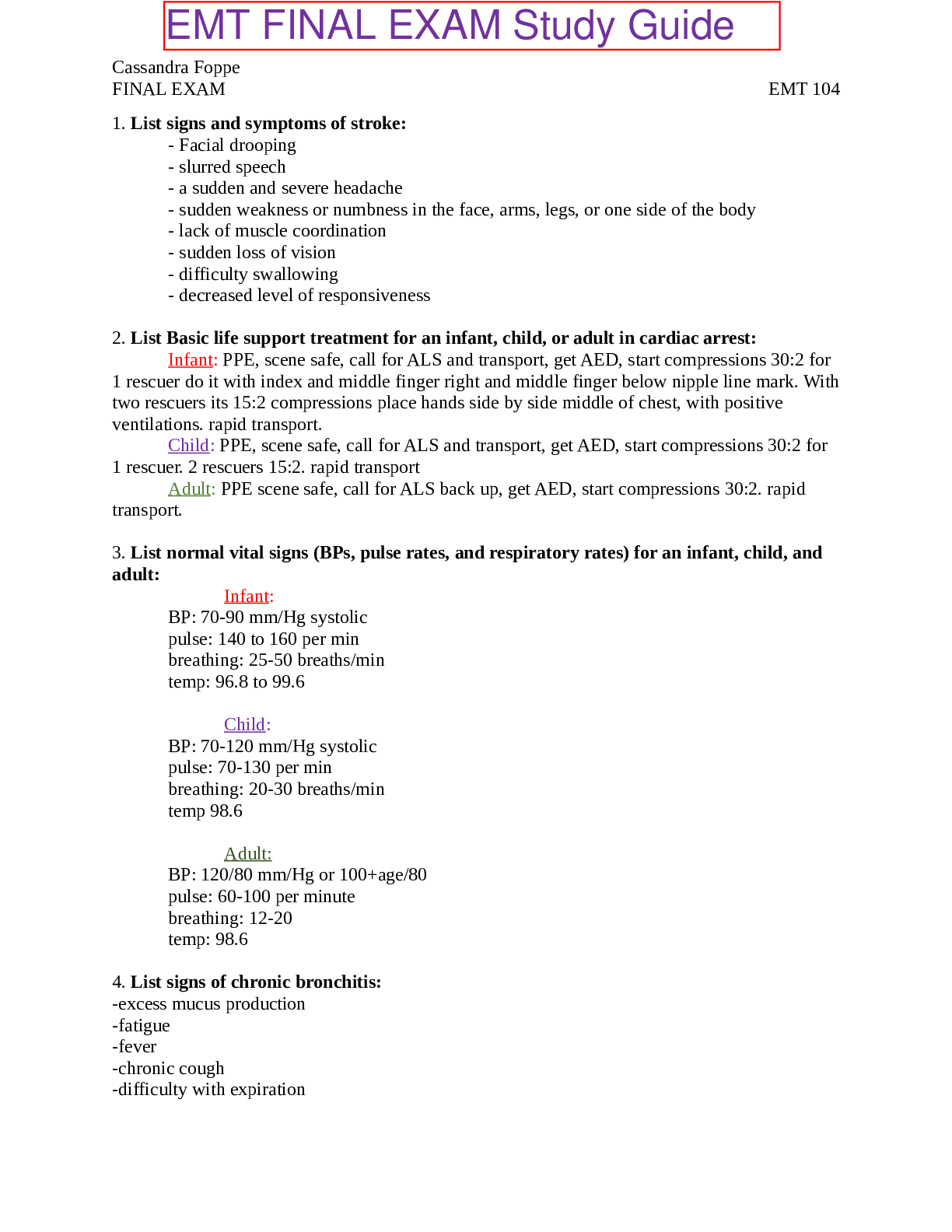
Buy this document to get the full access instantly
Instant Download Access after purchase
Buy NowInstant download
We Accept:

Also available in bundle (1)
Click Below to Access Bundle(s)
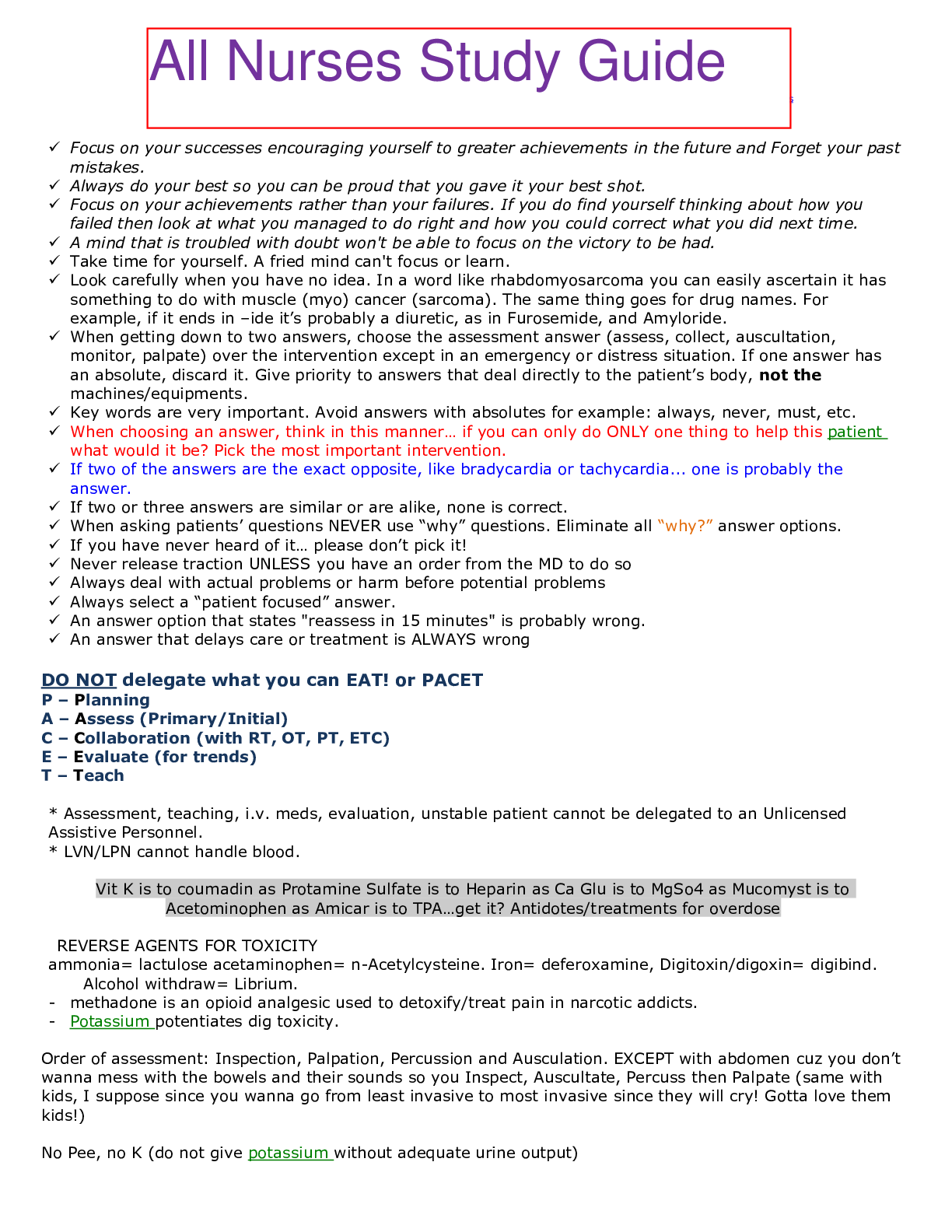
13 EMT Final Exam Study Guides AND Multiple Exam Questions and Answers. Most Comprehensive content for EMT Basic and Advanced Course and Exam Preparation.
EMT Final Exam Study Guide. Most Comprehensive Content for a quick read right before EXAM EMT Final Exam Study Guide. Best for quick exam preping NREMT Study Guide. Comprehensive Content. Medical,...
By Kirsch 4 years ago
$35
13
Reviews( 0 )
$13.00
Can't find what you want? Try our AI powered Search
Document information
Connected school, study & course
About the document
Uploaded On
Nov 22, 2021
Number of pages
17
Written in
All
Additional information
This document has been written for:
Uploaded
Nov 22, 2021
Downloads
0
Views
272




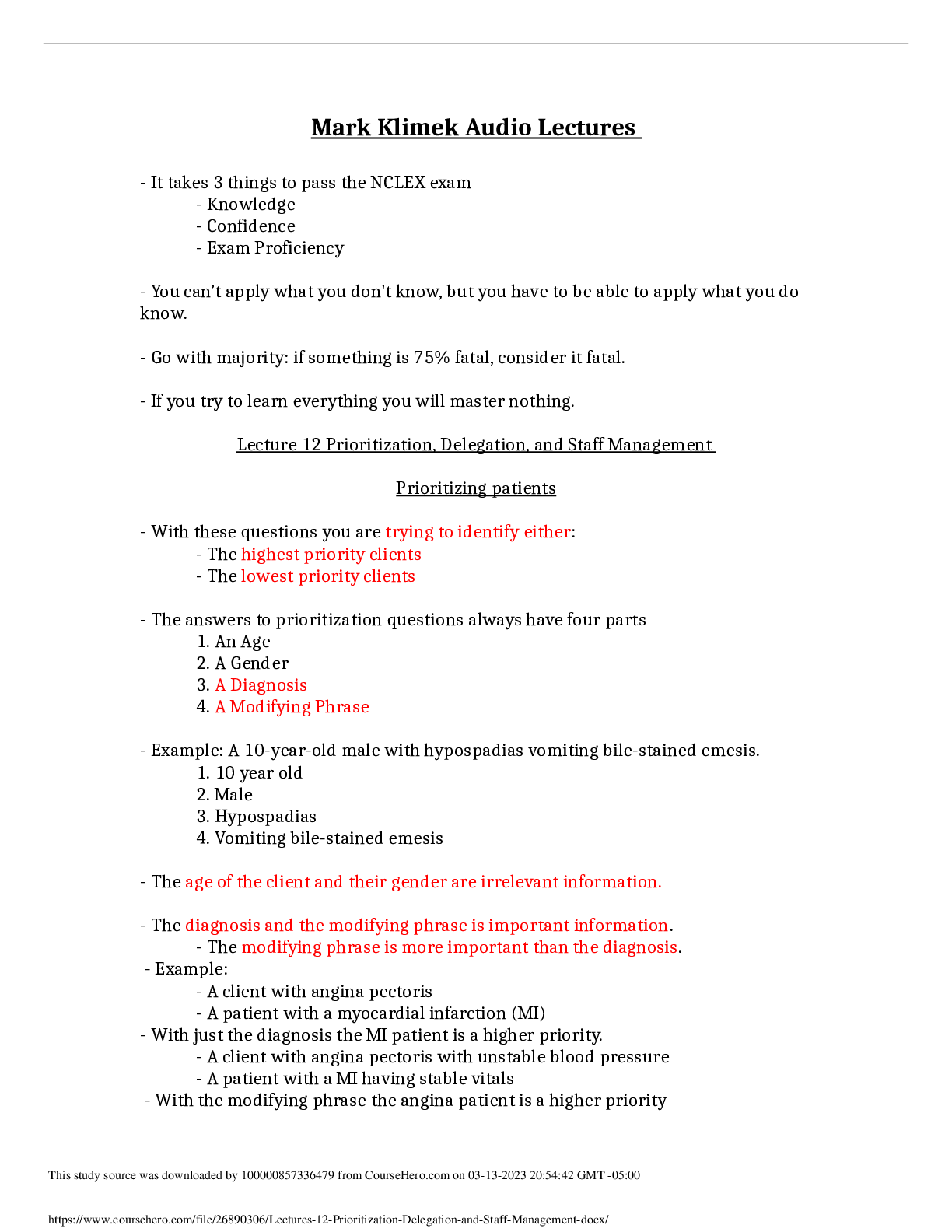



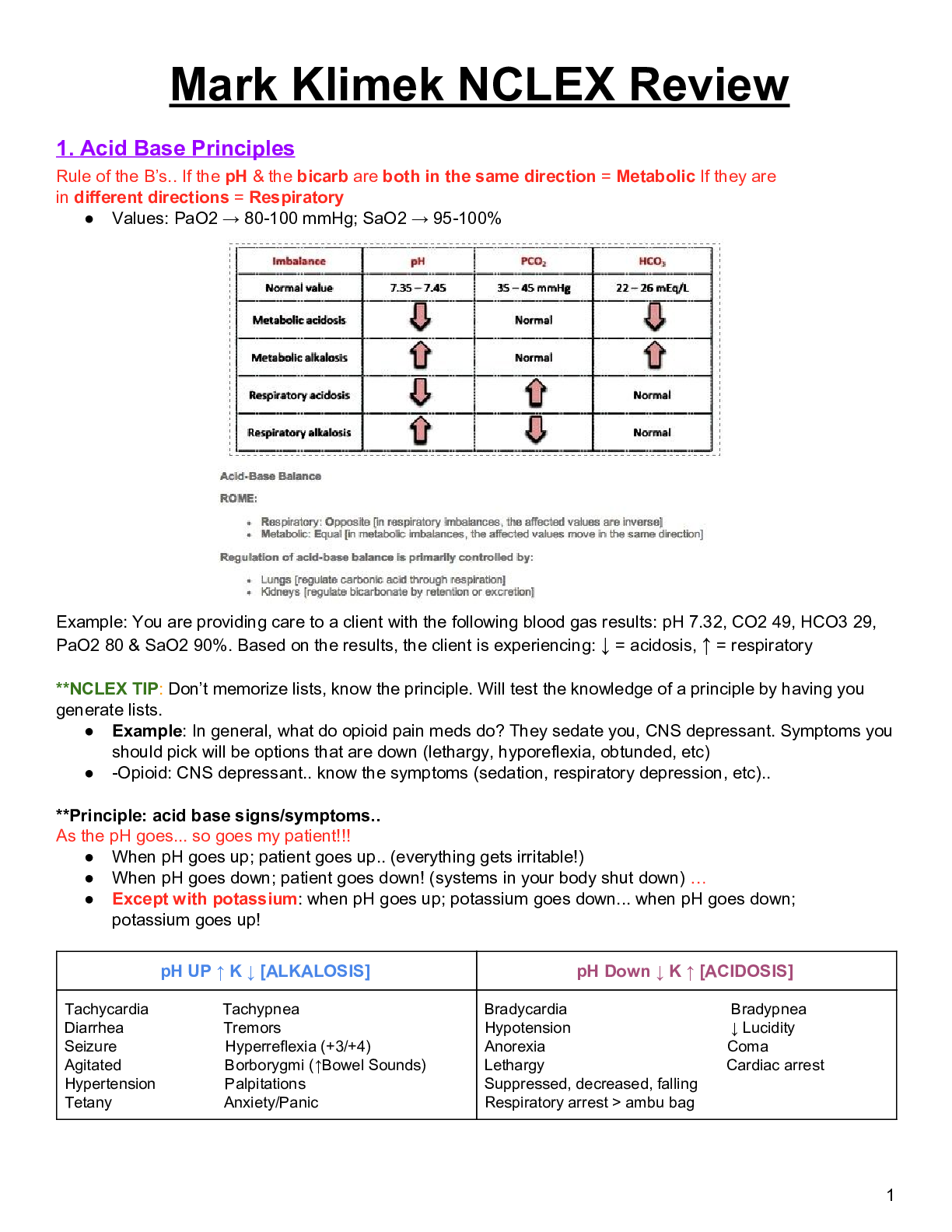
.png)



